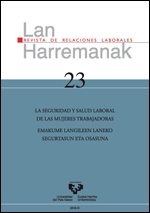La prevención de la violencia de género en el trabajo: análisis de la negociación colectiva del País Vasco
##plugins.themes.bootstrap3.article.main##
##plugins.themes.bootstrap3.article.sidebar##
Abstract
In this work we attempt to reflect on the prevention of sexual harassment and harassment on grounds of sex. To this end, we shall begin by briefly defining the concepts of sexual harassment and harassment on grounds of sex so as to then be able to identify this gender violence in the workplace as a psychosocial risk. We shall also explain the preventive guidelines that have been recommended by different authorities, in particular drawing attention to the European code of practice on measures to be taken against sexual harassment.
The article will then take a look at the specific regulatory framework contained in section 48 of the Constitutional Law governing effective equality among men and women (LOI), and we shall look into how this has been received within the collective autonomous framework. To this end, we have researched into all the agreements existing in the sector —both provincial and on a regional government level in the Basque Government— in order to ascertain the existence of relevant clauses or rules, drawing suitable conclusions from the results obtained. Lastly, we shall describe the UPV/EHU Agreement governing prevention and solution of complaints regarding harassment.
How to Cite
##plugins.themes.bootstrap3.article.details##
Authors who publish in the journal "Lan Harremanak" do so in agreement with the following terms:
1. Authors retain the copyright of their papers. while ceding to the journal "Lan Harremanak" the right to the first publication of their article.
2. The publisher UPV/EHU Press is a joint copyright holder, in order to protect the legitimate use of the published paper and compliance with CC terms.
3. Published papers are subject to a Creative Commons CC-BY license (unless stated otherwise) which permits third parties to share the paper, on the condition that the author and source are specified when material is reproduced.
4. Authors can enter into other non-exclusive license agreements regarding the published version of their work (e.g. depositing it in an institutional repository or re-publishing it as a monographic volume), providing the author and source are given appropriate credit.
5. Dissemination of submitted articles via Internet is both allowed and recommended (e.g. in institutional repositories and/or on the researcher's web page), both before and during the process of submission, since this can lead to interesting dialogues and also increase citations to the eventual publication.

